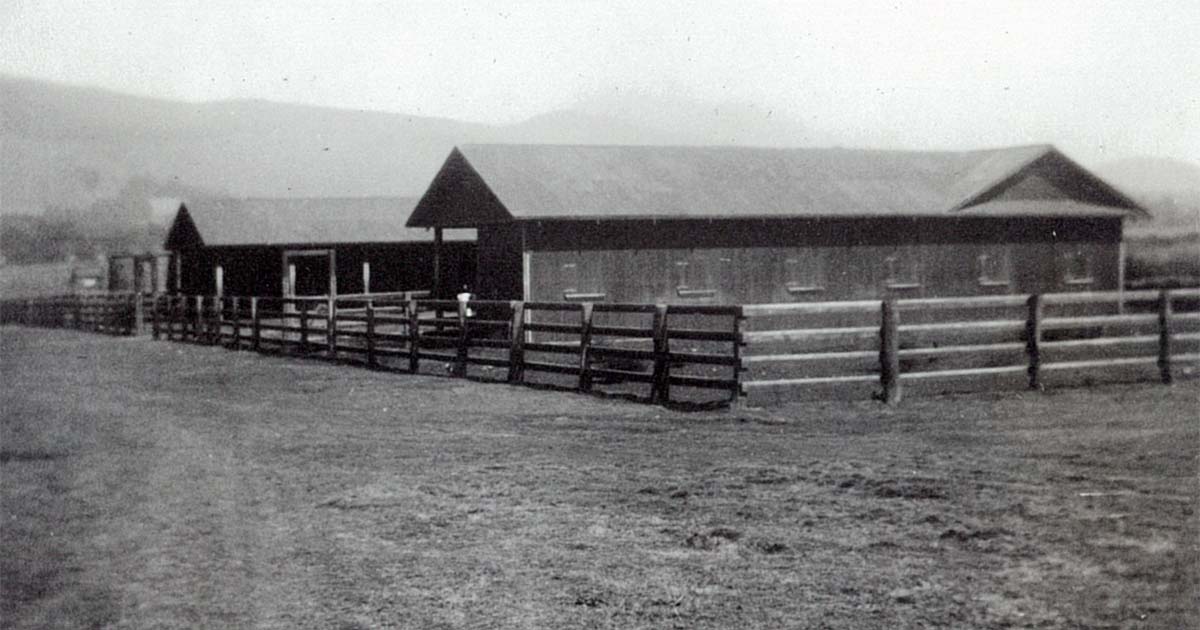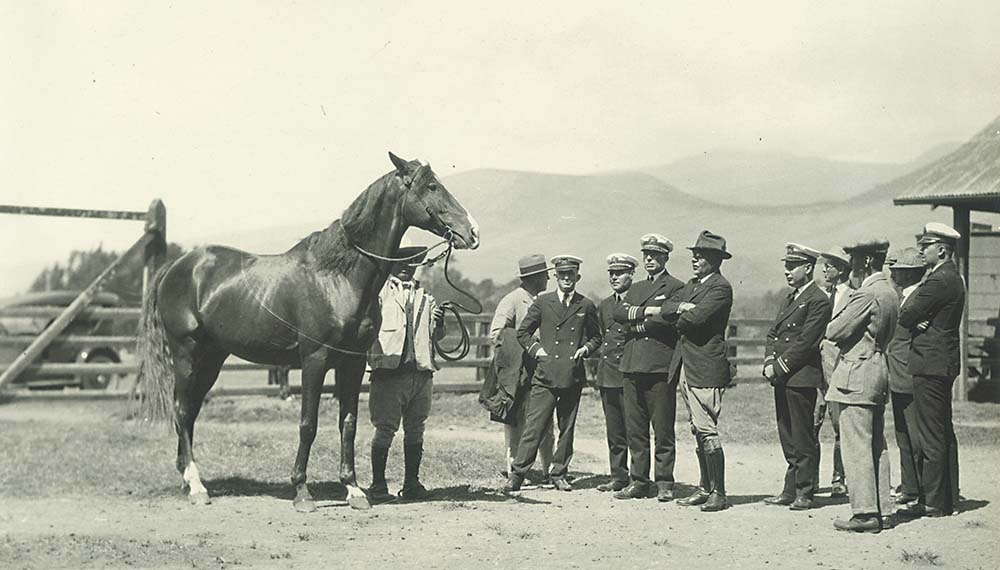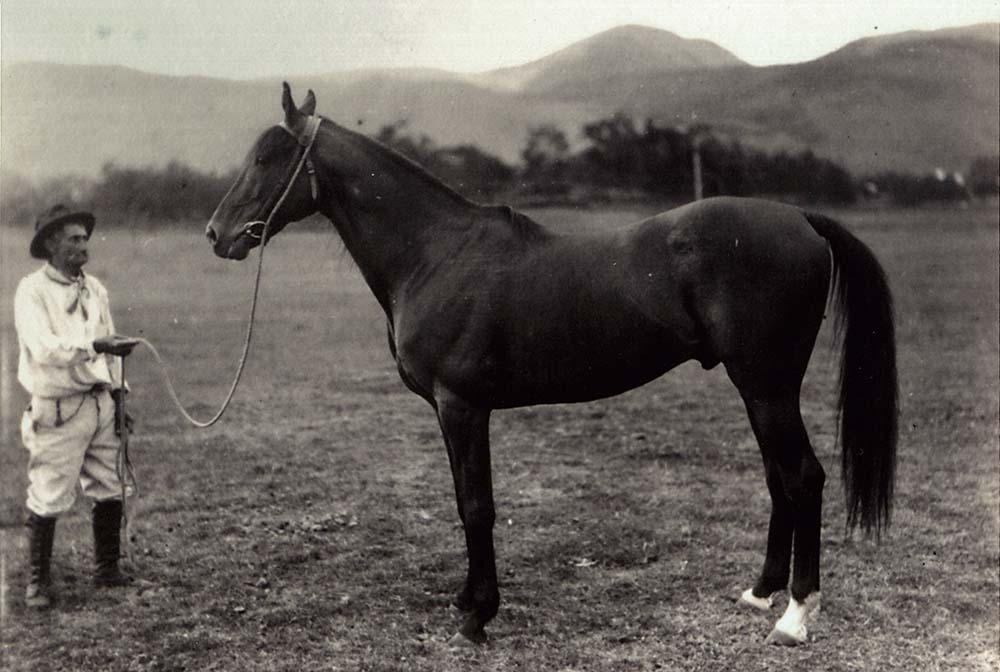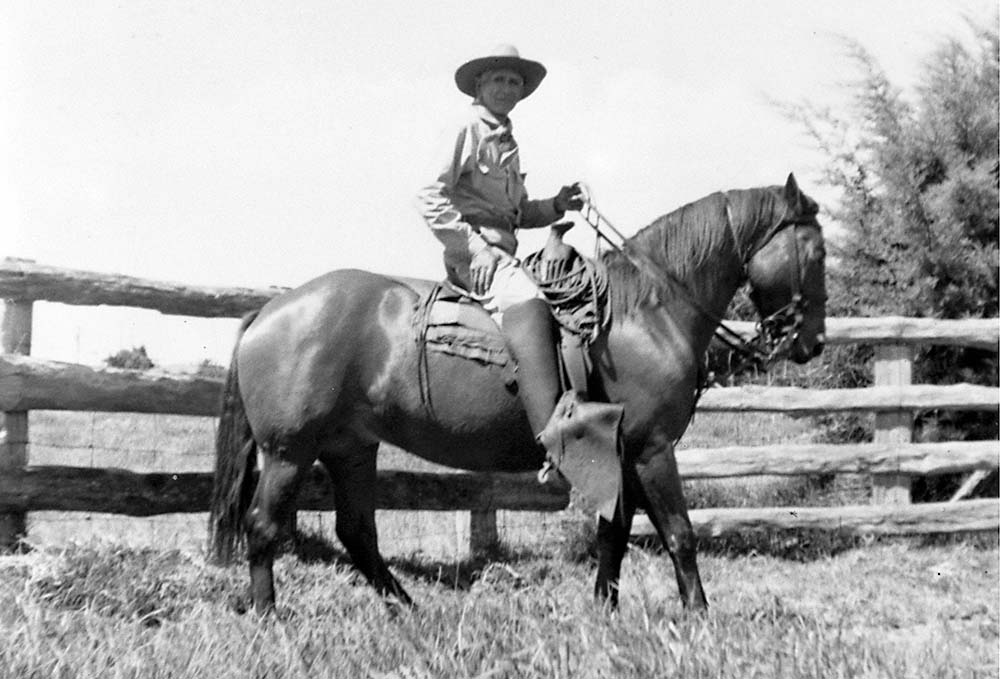
Pukalani Stallion Stables – 1920
By Dr. Billy Bergin
In old Waimea, a conglomerate of small hamlets made up the community that eventually became Kamuela. Pu‘uloa was the name of the kauhale (village) where W. M. Keck Center for Astronomy now stands. Makahikilua was the place name for the land upon which North Hawai‘i Community Hospital now sits.
Pu‘uiki was the name of the hamlet where Parker School (Old Barbara Hall and more recently Kahilu Hall) now holds classes and the village of Kanakanaka is the place name of the area across from Kahilu Hall that today accommodates both Catholic and Episcopalian Churches.
One of the more populated hamlets was Pukalani Village that, in the twilight of the 19th century, sported a bevy of thatched roofed abodes. Many deeded parcels in the area gradually became the property of early Parker Ranch though the diligence of John Palmer Parker II and A.W. Carter. The former ranch headquarters was moved from Mānā to Waimea to make room for the gala social events put on by Samuel Parker at the Parker homestead.
Pukalani was blessed with a dependable meandering tributary, Lanima‘uma‘u Stream, from the eastern fringe of the Waimea area. In times of storms, the excess tributary waters disappeared down a sink hole (pōhā) in a stand of trees just east of the Parker Ranch Race Track.
Pukalani Stables acquired its name from the historic place name of Old Waimea. The stables were designed and built by perennial Parker Ranch trustee A.W. Carter in 1909. An identical barn was built at the racetrack on the flat lands (pahu‘a) southeast of the track. Two separate stallion barns were built adjacent to the Racetrack Stables, each individually housing a pair of Thoroughbred stallions, although Pukalani stables was remained as the formal stallion station of Parker Ranch.
James “Palaika” Brighter collectively oversaw both stables while race training of the running colts was managed by Billy Carroll and later Bill Breitha. As Brighter’s responsibility included the Breaking Pen, the Rough Rider Foreman oversaw day-to-day operations of basic horse training.

Remount committee reviewing a prospect at Pukalani Stables
Day-to-day oversight of Pukalani Stables was executed by Samuel Awa‘a Sr, along with George Keola and William Duncan. Each stall served as home to a stallion during and after breeding season. Fourteen individual box stalls housed stallions of Arab, Thoroughbred, Standardbred, Morgan, German Coach, Percheron, and Belgian breeding.
A blacksmith shop (Hale ‘Āmala) was located behind (east) of Pukalani Stables. The 32 x 80-foot building had a large kapuahi (forge) as a centerpiece, surrounded by an array of kuahao (anvils). Stout wooden trays were hand receptacles for the hamale (hammers) and umi‘i (tongs) while two large pahu (drum barrels) of lānahu (coal) served the forge. Over the forge and suspended from the roof was a large ‘ūpā makani (bellows) that was manually activated by the strong arms of the kui‘hao (blacksmith).
Freight carriages were often housed within the blacksmith shop while under repair and maintenance. Small runabout carriages were kept in a small carriage barn which later became the equine surgery barn in modern times. Later it served as the headquarters for Cowboys of Hawai‘i commercial riding stable serving the visitor industry.
On the west end of the blacksmith shop was an open area that served as a farrier’s bay where draft horses and mules were shod. In the early 1950s, William Lindsey (Billy Mainaaupo) took over the Pukalani Stables and “upgraded” the farrier’s bay to include a shoeing stock. Behind the farrier’s bay stood a two-story house occupied by Theodore Vredenburg.
Mainaaupo’s treatment of Pukalani Stables was a dramatic upgrade in landscaping, building care, stall repair and turnout paddocks for stallion exercise. He built an attractive five rail board fence fronting the stables stained the ubiquitous Parker Ranch green. He trimmed the frontage fence with colorful and well-maintained flower beds of gladiolas and lilly. Working as a trainer/jockey, groom and gardener Tsuruo Nakata nurtured a row of Jacaranda trees that presently grace the roadside façade of Pukalani Stables. These were the glory days of these historic stables that rested on the laurels of decades gone by when nationally revered stallions each had box stalls of their own.
Shaped like an inverted “U” when viewed from the entrance, the stables were designed as 12×12 foot stalls with rafter heights of eighteen feet. There were two exceptions—each corner stall was larger (12×18) and had ceilings of fourteen feet, not open rafters. These were reserved for the special sires which were at least seventeen hands tall. The northeast corner stood Gold Oak, the noted sorrel remount Thoroughbred that out of Parker Ranch mares, produced many stakes winning offspring. In later years, Bel Canto, another seventeen-hand Thoroughbred called this stall home. Even today, kama‘āina horsemen refer to it as Bel Canto’s stall.

Gold Oak
In the opposite (southeast) corner was another 12×18 foot stall that housed another special stallion, Gladiator, a huge eighteen hand grey Percheron stallion that scaled in at a ton when he was imported by the ranch in 1915.
As is found at all barns, stations and saddle houses, a small kitchen/dining area was included in Pukalani Stables facilities. Small wood and later kerosene stoves were set in a corner of the comfort room where hot tea of koko‘olau was rendered during short mid-morning or mid-afternoon breaks. It was located where the modern day ladies room now sits.
As the ranch gradually moved from Thoroughbreds and draft sires, the stables accommodated Morgan and Quarter Horse stallions by the late 1950s when Mainaaupo was succeeded by amiable George Lindsey. His crew consisted of Kanakanui Iokepa and James Merseberg. For a five-year stint in the late 1950s, John Holi Ma-e, a Kūka‘iau Ranch retiree worked at these stables. In the period of 58/59, the author worked there along with the aforementioned crew.

John Holi Ma-e
Forage for the stallions was cut fresh each day and trucked in by Joe Cordeiro. Sickle cut; the grass was stacked in a heap via pitchfork in the central exit way to the east. The premises were swept and raked daily by the grooms who also mowed the central courtyard and tended to the bordering flower gardens.
Each afternoon, the cowboys would file past the entry way of the stables on their way home via their ahiahi (evening) horse that would be the mode of an early morning return to work. The home of each of the men on the cowboy gang was provided with an ahiahi usually pen a quarter to a half acre lot with carpet of kikuyu grass. None of the cowboys drove to work at Pu‘uhihale, the ancient heiau-like (altar) stone corral just south of Pukalani Stables.
Watch for The History of Pukalani Stables – Part II, coming next month!
